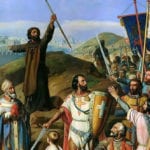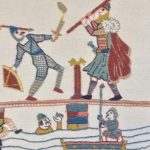 Mysteries
Mysteries  Mysteries
Mysteries  Creepy
Creepy 10 Scary Tales from the Middle Ages That’ll Keep You up at Night
 Humans
Humans 10 One-of-a-kind People the World Said Goodbye to in July 2024
 Movies and TV
Movies and TV 10 Holiday Movies Released at Odd Times of the Year
 Politics
Politics 10 Countries Where Religion and Politics Are Inseparable
 Weird Stuff
Weird Stuff 10 Freaky Times When Famous Body Parts Were Stolen
 Miscellaneous
Miscellaneous 10 Interesting Things Manufacturers Stopped Making and Why
 Gaming
Gaming 10 Funny Tutorials in Games
 History
History 10 Fascinating Little-Known Events in Mexican History
 Facts
Facts 10 Things You May Not Know about the Statue of Liberty
 Mysteries
Mysteries 10 Devastating Missing Child Cases That Remain Unsolved
 Creepy
Creepy 10 Scary Tales from the Middle Ages That’ll Keep You up at Night
 Humans
Humans 10 One-of-a-kind People the World Said Goodbye to in July 2024
Who's Behind Listverse?

Jamie Frater
Head Editor
Jamie founded Listverse due to an insatiable desire to share fascinating, obscure, and bizarre facts. He has been a guest speaker on numerous national radio and television stations and is a five time published author.
More About Us Movies and TV
Movies and TV 10 Holiday Movies Released at Odd Times of the Year
 Politics
Politics 10 Countries Where Religion and Politics Are Inseparable
 Weird Stuff
Weird Stuff 10 Freaky Times When Famous Body Parts Were Stolen
 Miscellaneous
Miscellaneous 10 Interesting Things Manufacturers Stopped Making and Why
 Gaming
Gaming 10 Funny Tutorials in Games
 History
History 10 Fascinating Little-Known Events in Mexican History
 Facts
Facts 10 Things You May Not Know about the Statue of Liberty
10 Brutal Family Battles for the Throne
In the annals of history, few tales captivate the imagination more than brutal family battles for the throne. These power struggles within royal bloodlines are shrouded in intrigue, treachery, and mystique, captivating generations with their dark allure. As ambition clashes with loyalty and kinship turn to rivalry, these epic conflicts have shaped empires and brought both triumph and tragedy to the forefront of history.
In this enigmatic journey through the corridors of power, we will delve into ten of the most harrowing family battles for the throne, unearthing the secrets and untold stories that have shaped the destiny of nations. Brace yourself for a captivating exploration of the human thirst for power and the price it exacts on those who dare to wear the crown.
Related: Top 10 Rulers Who Killed Their Wives
10 The Plantagenets: The War of the Roses
In the annals of English history, the Plantagenets reigned as one of the most prominent dynasties. Their rule was marked by intrigue and family feuds, none more brutal than the War of the Roses. This devastating conflict erupted between two rival branches of the Plantagenet family, the Houses of Lancaster and York, both claiming the right to the English throne.
The strife originated from their shared descent from King Edward III, which led to over 30 years of relentless battles, named after their respective symbols: the White Rose of York and the Red Rose of Lancasters. The key players in this tumultuous drama were King Henry VI and Queen Margaret of Anjou, leading the Lancastrians, and Richard, 3rd Duke of York, along with his sons Edward IV and Richard III, leading the Yorkists.
Battles like the infamous Battle of Towton saw Edward IV rise to the throne and later witnessed the shift in allegiances with Richard Neville, Earl of Warwick, turning the tide in favor of the Yorkists, putting an end to Lancastrian power. The final phase culminated in Henry Tudor’s challenge to Richard III, resulting in his victory at the Battle of Bosworth in 1485, and he took the crown as King Henry VII, ushering in the reign of the Tudors.[1]
9 The Habsburgs: The Spanish Succession
Amid the annals of history, the Habsburg family looms large, and their rule in Spain holds tales of power, intrigue, and a mysterious succession crisis. The War of the Spanish Succession (1701–1714) erupted after the demise of Charles II, the Spanish ruler, triggering a dispute over his throne. The conflict pivoted on whether the expansive Spanish Empire would pass to the House of Bourbon or the House of Habsburg, both laying claim to the coveted inheritance.
The dynastic claims were complex, entwined with marriages and renunciations, and the electoral prince Joseph Ferdinand emerged as the primary claimant. Eventually, a Partition Treaty was forged in 1698, seeking to maintain the balance of power in Europe by allocating different territories among the claimants.
Throughout the war, key players like Britain, the Dutch Republic, and the Holy Roman Emperor formed an anti-French alliance, engaging in brutal battles against Louis XIV’s forces. English forces, led by the Duke of Marlborough, achieved significant victories. The conflict culminated in the Peace of Utrecht in 1713, where Britain’s power ascended while French and Spanish influence waned.
The treaties of Rastatt and Baden were signed in 1714, solidifying the aftermath of the enigmatic and bloody War of the Spanish Succession. This gripping chapter of history unveils the intricacies of dynastic claims and the shadowy outcomes that shaped the course of European history.[2]
8 The Capets: The Hundred Years’ War
The Capet family, founders of the Capetian dynasty, held the French throne from 987 to 1328, playing a significant role in shaping the French nation-state. The dynasty’s first king, Hugh Capet, took power in 987 and skillfully secured the crown for his son Robert, implementing the practice of coronating heirs during the father’s lifetime to ensure stability and continuity.
However, the early Capetian kings faced challenges in expanding their dominion, relying on their wives for administrative work. Nonetheless, they gradually gained symbolic and practical power, strengthening their authority over other regional rulers and setting the stage for later conflicts.
One such conflict was the infamous Hundred Years’ War, which lasted from 1337 to 1453. This brutal war between England and France was marked by territorial disputes and claims to the French crown. Key players included the English monarchs, such as Edward III and Henry V, and French leaders, like King John II. The war witnessed devastating battles, both on land and at sea, including the famous Battle of Crécy and the capture of King John II. Numerous treaties were negotiated during the war, leading to the cession of territories and ransom payments for prisoners.[3]
7 The Romanovs: The Russian Revolution
The Romanov family, rulers of Russia from the 16th to the early 20th centuries, held significant influence over the empire. Beginning with Mikhail Romanov, who became the first Romanov czar in 1613, the family saw notable figures like Peter the Great and Catherine the Great, who expanded Russia’s power and embraced Western culture. However, Czar Nicholas II faced growing unrest during his rule, worsened by involvement in World War I and government corruption. Nicholas’s connection to the mystic Rasputin and his wife Alexandra’s influence further added to the family’s mysterious aura.
The Russian Revolution in 1917 marked the end of the Romanov dynasty. Nicholas II abdicated, and the family was held captive by Bolshevik forces until their execution in 1918. The last days of the Romanovs were filled with tragedy and observed by cleaners, revealing their contrasting modest nature and the anti-tsarist propaganda surrounding them.
In 1991, their remains were identified, providing closure and acknowledgment of their history. While rumors of Anastasia’s survival persisted, impostors like Anna Anderson fueled speculation. Ultimately, the Romanov dynasty’s enigmatic circumstances and tragic fate left a lasting imprint on Russian history.[4]
6 The Ptolemies: The Fall of Cleopatra
The Ptolemaic dynasty, established after Alexander the Great’s conquest, ruled Egypt for 275 years, blending Greek and Egyptian traditions. Ptolemy I Soter, the first ruler, focused on Egypt and built the famous library and museum in Alexandria, attracting scholars from all over the world. His successors, male rulers named Ptolemy and female rulers like Cleopatra VII, continued the dynasty’s legacy.
Cleopatra VII, known as Cleopatra the Great, was highly intelligent and multilingual and implemented monetary reform. However, volcanic eruptions during the Ptolemaic period caused “hydroclimatic shocks” impacting Nile floods, contributing to internal uprisings and social instability. These challenges influenced the Ptolemaic dynasty’s decline, and Egypt eventually fell under Roman rule.
The fall of Cleopatra remains steeped in mystery and intrigue. Cleopatra’s relationships with Julius Caesar and Mark Antony are well-known, but the details surrounding her famous “rug scene” remain shrouded in dramatization. Her intelligence, discipline, and active role in administration earned her the admiration of her people, despite Roman scorn.
Her legacy as the last ruler of the Ptolemaic dynasty, an educated and disciplined monarch, continued to be cherished by the Egyptians. After her defeat by Rome, Cleopatra chose suicide over capture, marking the end of the Ptolemaic dynasty and Egypt’s annexation by Rome. The mysterious circumstances surrounding Cleopatra’s final days continue to captivate historians and leave a lasting sense of wonder and fascination in the annals of history.[5]
5 The Umayyads: The Abbasid Revolution
The Umayyad Caliphate, ruling from Damascus, played a significant role in the Islamic empire’s history. The emergence of Sunni and Shiʿi sects led to conflicts, and the Umayyads faced challenges from caliphate pretenders, reclaiming Medina and Mecca. While investing in the Holy Cities and improving irrigation in Hejaz, they eventually faced the rise of the Abbasids, who overthrew them in 750.
The Abbasids upheld their legitimacy through Hashemite ancestry and a strict religious policy. The conflict between Sunni and Shiʿi branches and various sects further complicated the situation, with movements like the Fāṭimids and Qarmatians challenging Sunni Islam. The outcome of these brutal battles and power struggles shaped the course of the Islamic Caliphate, leading to shifts in political control and religious influence.
The mysterious circumstances surrounding the fall of the Umayyads and the rise of the Abbasids still captivate historians and scholars today. The support from Shiʿi Arabs and Persians, as well as the defeat of the Umayyads at the Battle of the Great Zab River, played significant roles in the Abbasids’ rise to power. The shifting of the caliphate’s focus eastward and the move of the capital to Baghdad brought about changes in the empire’s dynamics.
While the Abbasids promoted arts, science, and commerce during their golden age, their power eventually weakened due to the influence of non-Muslim mercenary forces in the army. The Mongol siege of Baghdad in 1258 marked the end of the Abbasid dynasty. These intricate and enigmatic events continue to intrigue scholars and history enthusiasts, reminding us of the complex and mysterious nature of the Umayyads and the Abbasid Revolution within the Islamic Caliphate.[6]
4 The Trastámaras: The Castilian Civil War
The Trastámara dynasty, established by Henry II in the late 14th century, played a significant role in shaping Christian Spain during the Middle Ages. Through strategic marriages, diplomacy, and warfare, they sought to unify the peninsular Christian kingdoms and acquired dominion over neighboring regions. The dynasty’s reign endured until 1504, marked by challenges and triumphs, including defeating rivals like Henry of Trastámara and achieving a powerful union between the Crowns of Castile and Aragon, making them one of the most influential monarchs in Europe alongside the Valois of France.
The House of Trastámara’s fascinating history and its renowned members, such as the “Catholic Monarchs” Isabella I of Castile and Ferdinand II of Aragon, add an air of mystery to their rule. The dynasty’s founding by Henry II of Castile, an illegitimate son of Alfonso XI, and the privileges granted to his mistress Eleanor de Guzmán and their children, including Henry, named Count of Trastámara, reveal a complex family dynamic that set the stage for intrigue and rivalries.
The demise of Joanna of Castile as the final ruler of the House of Trastámara marked the end of an era, with the crowns of Castile and Aragon passing to the Habsburgs. The intricate relationships and tumultuous events surrounding the dynasty, such as Maria of Portugal’s revenge upon Eleanor after Alfonso’s death, further add to the mysterious circumstances and outcomes of their rule.[7]
3 The Ottomans: The Ottoman Interregnum
The Ottoman family, known as the Ottomans, established and ruled over the vast Ottoman Empire for centuries. Originating as a small principality in Anatolia, the Ottomans rapidly expanded their territory, eventually dominating Southern & Eastern Europe, parts of the Middle East, North Africa, Crimea, and the Caucasus, along with Mediterranean islands. The Ottoman Empire reached its height as a global military superpower during the 15th to 17th centuries, encompassing a diverse array of cultures and peoples under its rule.
During the Ottoman Interregnum, a period from 1402 to 1413, the empire faced internal strife and uncertainty following the defeat of Sultan Yildirim Bāyezīd I by Timur in the Battle of Ankara. This power vacuum led to a struggle for succession among Bāyezīd’s heirs, resulting in a brutal battle for the throne.
Fratricide became a recurring theme during this period as brothers fought against each other to claim the throne. The Interregnum remains an enigmatic period in Ottoman history, with limited historical sources available for study. Nonetheless, it played a formative role in shaping the politics and historical consciousness of the Ottoman Empire.[8]
2 The Ming: The Tumu Crisis
The Ming dynasty, which thrived in China from 1368 to 1644, was a period of remarkable native Chinese rule that left a lasting impact on the country’s history. Founded by Zhu Yuanzhang, known as Hongwu, the dynasty wielded substantial cultural and political influence across East Asia, reaching regions as far as Vietnam and Myanmar. The Ming dynasty stood as a stable yet autocratic ruling power during its reign.
During the Ming dynasty, the Tumu Crisis unfolded in 1449, plunging China into turmoil. The crisis was triggered when Oirat forces captured Beijing and imprisoned the Yingzong Emperor, leading to several brutal battles along the Great Wall with nomadic minorities. The Tumu Crisis exposed weaknesses in the Ming dynasty’s military system, such as low-quality military personnel and inefficient supply systems, contributing to their defeat against the Oirats.
Moreover, historical records indicate that climate change, particularly the Spörer Minimum in Europe from the 1450s, might have played an undisclosed role in exacerbating social unrest and upheaval during this period. The circumstances and outcomes of the Tumu Crisis remain mysterious, leaving historians intrigued by the complex interplay of climate, military weaknesses, and political turmoil during this pivotal period in Chinese history.[9]
1 The Julio-Claudians: The Year of the Four Emperors
The Julio-Claudian dynasty was the first imperial dynasty of Rome, ruling from AD 14 to 68. It consisted of four successors of Augustus: Tiberius, Caligula, Claudius I, and Nero. Despite not being a direct bloodline, they were connected through adoption and family ties.
Tiberius proved capable in the beginning but later succumbed to tyranny. Caligula’s erratic behavior led to his assassination. Claudius left a significant impact on the empire’s development, expanding territories and advancing Romanization. Nero, infamous for his vices, oversaw a prosperous empire, yet rebellion and civil strife marked the dynasty’s end, particularly during the tumultuous Year of the Four Emperors in AD 69. The year saw brutal paranoia among subsequent emperors and a violent civil war, culminating in Galba taking power.
The Year of the Four Emperors followed Nero’s death and witnessed a chaotic struggle for power. Four men declared themselves emperor, with Galba ultimately taking control. His strictness and financial decisions sparked discontent among his troops. The Julio-Claudian dynasty’s fall and the ensuing power struggle left Rome in a state of turmoil and uncertainty, causing great upheaval within the empire. The legacy of the Julio-Claudians was marked by a complex interplay of family, ambition, and intrigue, with the outcomes of their reigns shaping the course of Roman history.[10]








